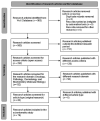Scientific Research Directions on the Histopathology and Immunohistochemistry of the Cutaneous Squamous Cell Carcinoma: A Scientometric Study
- PMID: 36295609
- PMCID: PMC9611311
- DOI: 10.3390/medicina58101449
Scientific Research Directions on the Histopathology and Immunohistochemistry of the Cutaneous Squamous Cell Carcinoma: A Scientometric Study
Abstract
Introduction: Cutaneous squamous cell carcinoma (cSCC) is one of the most frequently occurring types of cancer in humans. Scientometric research is an innovative method for analyzing the research trends in various domains, with great implications in the field of medicine. Materials and Methods: We searched the Web of Science database with the following established query terms: "Squamous cell carcinoma", "skin", and "immunohistochemistry". After applying the inclusion and exclusion criteria, a total of 76 articles were selected. The present study aims to analyze, based on the frequency of use of keywords with scientometric algorithms and map-based distributions, the trends of the research concerning cSCCs in 2017-2022. Results: A graphical representation based on 11 scientometric maps presented the division of the keywords into seven clusters, from which seven categories of research interest were defined. The clusters represent a multidisciplinary approach to the diagnosis and treatment of cSCCs, cancer diagnostics, patient outcomes, histopathological importance, management of cSCCs, role of progression, and adequate treatment of and importance of immunohistochemistry for cSCCs. The distribution of the citations shows the importance of the available research on cSCCs by analyzing the first five most-cited articles included in our study in direct concordance with the seven defined clusters. Conclusion: The scientometric research method reveals the interest of research in the multidisciplinary approach used to obtain the best outcomes for the patient, including a targeted investigation, as well as diagnostic and treatment options. The trends in the research reveal that histopathological diagnostics and immunohistochemistry, combined with molecular techniques, are the most important tools used to establish a personalized diagnosis, thus increasing the quality of life and life expectancy for patients with cSCCs.
Keywords: dermatology; histopathology; immunohistochemistry; scientometry; squamous cell carcinoma.
Conflict of interest statement
The authors declare no conflict of interest.
Figures







Similar articles
-
Incidence of Multiple vs First Cutaneous Squamous Cell Carcinoma on a Nationwide Scale and Estimation of Future Incidences of Cutaneous Squamous Cell Carcinoma.JAMA Dermatol. 2020 Dec 1;156(12):1300-1306. doi: 10.1001/jamadermatol.2020.3677. JAMA Dermatol. 2020. PMID: 33112377 Free PMC article.
-
Metastasis suppressor proteins in cutaneous squamous cell carcinoma.Pathol Res Pract. 2016 Jul;212(7):608-15. doi: 10.1016/j.prp.2015.12.018. Epub 2016 May 6. Pathol Res Pract. 2016. PMID: 27215390
-
European interdisciplinary guideline on invasive squamous cell carcinoma of the skin: Part 1. epidemiology, diagnostics and prevention.Eur J Cancer. 2020 Mar;128:60-82. doi: 10.1016/j.ejca.2020.01.007. Epub 2020 Feb 26. Eur J Cancer. 2020. PMID: 32113941
-
Epidemiology of advanced cutaneous squamous cell carcinoma.J Eur Acad Dermatol Venereol. 2022 Jan;36(1):39-50. doi: 10.1111/jdv.17709. Epub 2021 Oct 11. J Eur Acad Dermatol Venereol. 2022. PMID: 34592000 Review.
-
Diagnosis and treatment of invasive squamous cell carcinoma of the skin: European consensus-based interdisciplinary guideline.Eur J Cancer. 2015 Sep;51(14):1989-2007. doi: 10.1016/j.ejca.2015.06.110. Epub 2015 Jul 25. Eur J Cancer. 2015. PMID: 26219687 Review.
Cited by
-
Immunohistochemical Expression Levels of Epidermal Growth Factor Receptor, Cyclooxygenase-2, and Ki-67 in Canine Cutaneous Squamous Cell Carcinomas.Curr Issues Mol Biol. 2024 May 19;46(5):4951-4967. doi: 10.3390/cimb46050297. Curr Issues Mol Biol. 2024. PMID: 38785565 Free PMC article.
-
Research Hotspots in Psoriasis: A Bibliometric Study of the Top 100 Most Cited Articles.Healthcare (Basel). 2023 Jun 26;11(13):1849. doi: 10.3390/healthcare11131849. Healthcare (Basel). 2023. PMID: 37444683 Free PMC article. Review.
-
Pathophysiology, Histopathology, and Differential Diagnostics of Basal Cell Carcinoma and Cutaneous Squamous Cell Carcinoma-An Update from the Pathologist's Point of View.Int J Mol Sci. 2024 Feb 13;25(4):2220. doi: 10.3390/ijms25042220. Int J Mol Sci. 2024. PMID: 38396897 Free PMC article.
References
-
- Elder D.E., Massi D., Scolyer R.A., Willemze R., Cancer L., Al E. WHO Classification of Skin Tumours. International Agency for Research on Cancer; Lyon, France: 2018.
-
- Bucătaru C., Săvescu D., Repanovici A., Blaga L., Coman E., Cocuz M.-E. The Implications and Effects of Medical Waste on Development of Sustainable Society—A Brief Review of the Literature. Sustainability. 2021;13:3300. doi: 10.3390/su13063300. - DOI
-
- Ramezani M., Masnadjam M., Azizi A., Zavattaro E., Khazaei S., Sadeghi M. Evaluation of C-Kit (CD117) Expression in Patients with Squamous Cell Carcinoma (SCC) and Basal Cell Carcinoma (BCC) of the Skin. Aims Mol. Sci. 2021;8:51–59. doi: 10.3934/molsci.2021004. - DOI
MeSH terms
LinkOut - more resources
Full Text Sources
Medical

